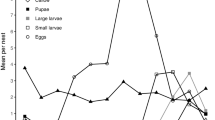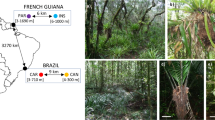Summary
Exoneura bicolor is a univoltine allodapine bee common in montane forests of southern Australia, where it exhibits a semisocial/quasisocial colony organization. Within-nest behaviour in postemergence autumn nests ofExoneura bicolor was recorded with the aim of studying behavioural specialization in pre-reproductive colonies. Ten complete colonies were transferred to purpose-built observation nests shortly before brood eclosion in late summer. Behaviour within observation nests was recorded for periods of up to 44 days after establishment, covering a period when colonies are preparing for overwintering. Dispersal of females and brood rearing do not occur at this time, although some females may become inseminated. Analyses of data using multivariate techniques indicated four distinguishable behavioural castes, designated here as Guards, Nest Absenters, Nest Modifiers and Non-recruits. This represents a higher degree of behavioural specialization than recorded to date for other allodapines. Behaviours performed by Guards and Nest Absenters are likely to involve considerable risks, but benefit the colony as a whole, so that some nestmates in prereproductive colonies exhibit altruism that frequently aids adult siblings or cousins. The males in our study were fed by females via trophallaxis and two of the males participated in nest maintenance tasks. Our results suggest that autumn colonies ofE. bicolor form well-integrated behavioural units even though brood rearing does not commence until the following spring.
Similar content being viewed by others
References
Maeta, Y., S. F. Sakagami and C. D. Michener, 1985. Laboratory studies on the life cycle and nesting biology ofBraunsapis sauteriella, a social xylocopine bee (Hymenoptera: Apidae).Sociobiol. 10:17–41.
Mason, C. A., 1989. Division of labor and adult interactions in eusocial colonies of two allodapine bee species (Hymenoptera: Anthophoridae).J. Kansas Entomol. Soc. 61:477–491.
Michener, C. D., 1971. Biologies of African allodapine bees (Hymenoptera: Xylocopinae).Bull. Am. Mus. Na. Hist. 145:221–301.
Michener, C. D., 1974.The Social Behavior of the Bees. Harvard University Press, Cambridge.
Michener, C. D., 1990. Castes in Xylocopine bees. In:Social Insects: an evolutionary approach to castes and reproduction. (W. Engels, Ed.). Springer-Verlag, Berlin, pp. 123–146.
O'Keefe, K. J. and M. P. Schwarz, 1990. Order of eclosion and reproductive differentiation in a social allodapine bee.Ethol. Ecol. Evol. 3:233–245.
Sakagami, S. F. and Y. Maeta, 1985. Multifemale nests and rudimentary castes in the normally solitary beeCeratina japonica (Hymenoptera: Xylocopinae).J. Kansas Entomol. Soc. 57:639–656.
Sakagami, S. F. and Y. Maeta, 1987. Multifemale nests and rudimentary castes of an “almost” solitary beeCeratina flavipes, with additional observations on multifemale nests ofCeratina japonica (Hymenoptera: Apoidea).Kontyu 55:391–409.
Schwarz, M. P., 1986. Persistent multi-female nests in an Australian allodapine bee,Exoneura bicolor (Hymenoptera: Anthophoridae).Ins. Soc. 33:258–277.
Schwarz, M. P., 1987. Intra-colony relatedness and sociality in the allodapine beeExoneura bicolor.Behav. Ecol. Sociobiol. 21:387–392.
Schwarz, M. P., 1988. Local resource enhancement and sex ratios in a primitively social bee.Nature 331:346–348.
Schwarz, M. P. and K. J. O'Keefe, 1991. Cooperative nesting and ovarian development in females of the predominantly social beeExoneura bicolor Smith after forced solitary eclosion.J. Aust. ent. Soc. 30:251–255.
Schwarz, M. P., O. Scholz and G. Jensen, 1987. Ovarian inhibition among nestmates ofExoneura bicolor Smith (Hymenoptera: Xylocopinae).J. Aust. ent. Soc. 26:355–359.
Sneath, P. H. A. and R. R. Sokal, 1973.Numerical Taxonomy. W. H. Freeman and Company, San Francisco.
Author information
Authors and Affiliations
Rights and permissions
About this article
Cite this article
Melna, P.A., Schwarz, M.P. Behavioural specialization in pre-reproductive colonies of the allodapine beeExoneura bicolor (Hymenoptera: Anthophoridae). Ins. Soc 41, 1–18 (1994). https://doi.org/10.1007/BF01240569
Received:
Revised:
Accepted:
Issue Date:
DOI: https://doi.org/10.1007/BF01240569




